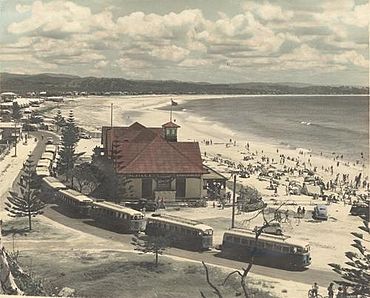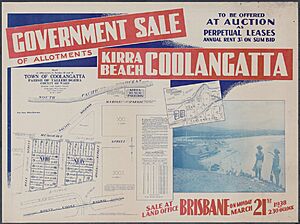Kirra, Queensland facts for kids
Quick facts for kids KirraGold Coast, Queensland |
|
|---|---|

Kirra Surf Life Saving Club, Circa 1946
|
|
| Postcode(s) | 4225 |
| LGA(s) | City of Gold Coast |
| State electorate(s) | Currumbin |
| Federal Division(s) | McPherson |
Kirra is a cool beach neighborhood located on the Gold Coast in Queensland, Australia. It's actually part of the larger suburb called Coolangatta. Kirra is well-known for its beautiful beaches and awesome surfing spots.
Contents
Discover Kirra's Geography
A small rocky area called Kirra Point separates Kirra Beach to the north from Coolangatta Beach to the south. This point is famous for being one of the best surf breaks in the world! In the past, the waves here were known for creating amazing "barrels" – that's when the wave curls over, forming a hollow tube. However, because of sand being pumped from the Tweed River mouth, the surf break has changed quite a bit.
Kirra's Past: A Look at History
The name Kirra comes from Kirra Hill, which is about 27 meters (89 feet) above sea level. This name first appeared on a map in 1883. People believe it's an Indigenous name, but its exact meaning isn't known. For example, in the Yuggera language, kaiyar means white cockatoo, and in the Kabi language, kirran means fire.
Early Days and Visitors
Before 1840, Kirra wasn't known by its current name. Not many white settlers visited this area back then.
Between 1840 and 1910, the first white holiday-makers started to discover Kirra. They came to enjoy the beautiful beaches.
From 1910 to 1920, more and more people started visiting. Kirra quickly became a very popular spot for holidays and recreation.
In April 1914, some land in Kirra was put up for sale. There were 18 spots for homes and businesses. These spots were advertised as being near the beach and a possible railway stop.
Growing Popularity and Changes
In the 1930s, a new road called the South Coast Road opened. This made it much easier to get to the southern Gold Coast, making it an even more popular holiday spot. Camping was a big hit for families because Kirra had a long beach and low sand dunes.
In 1938, the Queensland Government sold some land at Kirra that used to be swampy.
From 1960 to early 1974, the Tweed River breakwaters (barriers built in the water) and bad weather caused a lot of sand to wash away from the beach. The water level came very close to the coastal road.
The Big Groyne and Sand Pumping
In May 1972, the Government of Queensland built a long barrier called a groyne at Kirra Point. People called it the "big groyne." Its purpose was to trap sand and help build up Coolangatta beach to the south. The growing tourism industry needed sandy beaches, and Coolangatta had problems with sand washing away.
Surfers were worried this groyne would ruin the waves, and they held protests. They were right at first; a deep hole formed near the groyne. But after that first year, the sand came back, and the waves were good again.
Later, a second, smaller barrier called "little groyne" was built a bit north on Kirra beach. In 1995, 30 meters (98 feet) was removed from the Big Groyne to help with sand erosion at Greenmount Beach. Today, both groynes are almost completely covered by sand from the ongoing sand pumping.
In 2001, a big project started to move sand from the Tweed River mouth to the beaches. This is called the sand bypass project.
By 2003, the Little Groyne was completely buried under the sand.
In 2006, the Griffith University Coastal Management Center started a project to help restore the beach.
Kirra's Environment and Sea Life
The sand pumping has also affected the local reef. This reef used to be a popular spot for diving, full of amazing sea creatures like manta rays and wobbegongs (a type of shark). But since the sand pumping started, the reef has been covered. Dive companies have had to move or focus on other smaller reef areas. The sand pumping is planned to continue until 2024, when the project will be reviewed.



